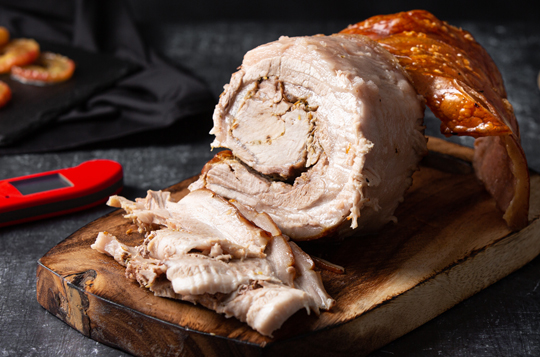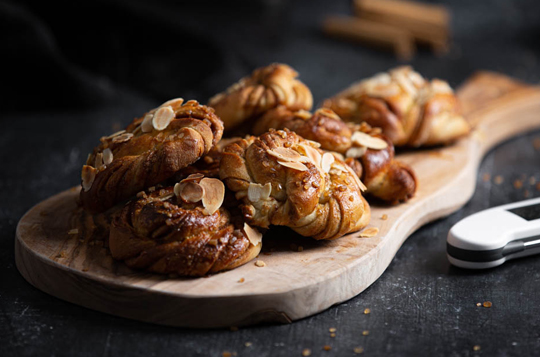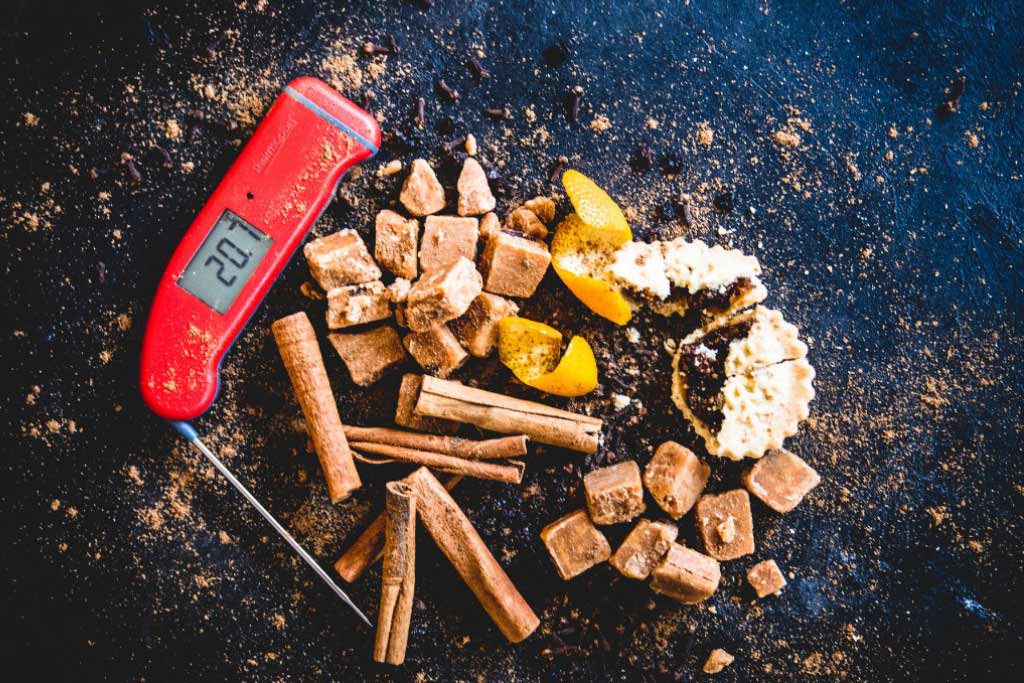Cook perfect dishes every time with our food temperature chart.
Discover what temperature food should be cooked to — including cooked chicken, sausages and beef, as well as baked goods like bread, cake and jam. Our guide includes a meat temperature chart to help you cook yours exactly how you like it. Plus, make sure to check out the FAQs at the bottom of the page for more temperature tips for safe and delicious food.
The number one meat cooking temperature chart.
Meat cooking temperatures
Fish 60 °C
Beef, Lamb, Veal & Duck (Rare) 52 °C
Beef, Lamb, Veal & Duck (Medium) 60 °C
Beef, Lamb, Veal & Duck (Well Done) 71 °C
Pork Roasts, Steaks & Chops (Medium) 63 °C
Pork Roasts, Steaks & Chops (Well Done) 71 °C
Sausages 71 °C
Beef Burgers 75 °C
Slow Cooked Meat (Brisket, Pork/Lamb Shoulder, Ribs)
93-95 °C

Turkey cooking temperatures
Defrosted Turkey -1 to 4°C
Top Tip: Remove the turkey from the oven when it reaches 67°C. As it rests, the turkey meat temperature will rise to a safe and succulent 74°C.
Monitor the turkey as it cooks with a leave-in turkey thermometer, like the DOT. It will alert you when the temperature of your turkey is spot-on.
Double-check the internal temperature all over with an instant-read thermometer, such as the Thermapen ONE. Temperatures can vary in big pieces of meat, so ensure it's safe to eat throughout.
best turkey Thermometers
Meat cooking temperatures
- Red meat roasts and steaks can be tricky to cook to your desired finish. Cutting into the meat to check if it's done will spoil it, and removing it from the heat a few minutes too soon or too late can leave you with an inedible meal. Cooking times will never guarantee you a perfect finish. For roasts like beef and lamb, we recommend using a leave-in meat thermometer to ensure you get it spot on. Always place the probe into the thickest part of the meat.
- Pork temperature charts are useful to have for pork roasts and cuts of pork like steaks and pork chops. You can cook pork to a medium or well-done temperature depending on your preference.
- Poultry is one of the most important foods to cook to temperature for food safety. Whether you're preparing chicken breasts, chicken thighs or turkey, always cook to temperature using a food thermometer. When chicken cooks, all of the harmful bacteria is destroyed at an internal temperature of 74 °C.
- Like chicken, cooking burgers and ground meat to a certain temperature is important for food safety. Beef burger patties should be cooked to 71 °C to be safe to consume. Cooking medium rare burgers at home isn't usually recommended because ground meat can contain harmful bacteria, so to create perfect burgers cook to the safe burger temperature of 71 °C.
Baking temperatures
Rich Dough 77 °C
Lean Dough 88 - 93 °C
Sourdough 97 °C
Sponge Cake 95 - 98 °C
Fruit Cake 98 - 100 °C
Yeast (Water temp.) 41 - 46 °C
Butter (Softened) 18 - 19 °C
Jam (Setting Point) 105 °C

CONFECTIONERY temperatures
Soft Ball (Fudge) 112 - 116 °C
Soft Crack (Butterscotch) 132 - 143 °C
Firm Ball (Caramel) 118 - 120 °C
Hard Ball (Nougat) 121 - 130 °C
Hard Crack (Toffee/Lollipops) 149 - 154 °C

REHEATING temperatures
All reheated foods 75 °C
All reheated foods, whether thats precooked meat or vegetables, should reach and maintain a temperature
of 75 °C for 30 seconds before consumption.

There are a number of reasons for using temperature as a guide when cooking meat, baking, creating confectionery and reheating food.
There are a number of reasons for using temperature as a guide when cooking meat, baking, creating confectionery and reheating food.
- With some foods like chicken, ground meat and foods that have been pre-cooked, it's crucial to heat them to a specific temperature in order to be safe to consume.
- Steaks and red meat roasts can be tricky to cook to your desired finish. Cooking to a specific temperature is the only way to ensure they are spot on, every time. We have also included a pork temperature chart above and the safe to consume, well done chicken temp. Its important both pork and chicken are cooked to the correct internal temperature for both safety and quality reasons.
- For baked goods, monitoring the temperature of your ingredients will help you create consistency. Using temperature as a guide is key to getting that perfect rise.
- Temperature is crucial to confectionery, many processes such as caramel, jam and Italian meringue rely on precise temperatures for the ideal consistency.
Cooking Temperature Tips
The safe cooked chicken temp is 74 °C. For whole chickens, make sure it reaches a minimum internal temperature of 74 °C. Use a food thermometer to probe the bird in a few of the thickest places, between the breast and thigh.
With whole birds like chickens and turkeys, their temperature will continue to rise as they rest. This is called carryover cooking. A top tip is to remove your bird from the oven a little early, around 67 °C, and it will rise to the cooked temp for chicken or turkey as it rests. This will ensure it's perfectly cooked and juicy.
All poultry carry a risk of bacteria such as salmonella and Campobylacter. The more intensively farmed the bird, the greater the risk that the meat will carry harmful bacteria. Because duck is typically less intensively farmed than birds like chicken, many people consider it low risk to cook it to lower temperatures.
Duck is therefore commonly served medium rare because this is when it is at its most tender, juicy and flavoursome. The recommended cooked temperature for duck is the same as red meat because they are similar in texture: 52 °C for rare, 60 °C for medium and 71 °C for well done.
The temp for cooking pork depends on your preference — pork roasts and cuts of pork like steaks and pork chops can have a medium or well-done finish. Follow the pork temperature chart above to cook your pork to your liking.
It's essential to cook sausages to temperature because they are made of ground meat. The cooking temp for sausages is 71 °C — they must reach this temperature to be safe to eat. When cooking a batch of sausages, make sure to probe at least a few. Some can be cooked while others are underdone.
You should always cook steak and roast beef to temperature to ensure the perfect rare, medium or well-done finish. Cutting into the meat to check if it's done will spoil it, and removing it from the heat a minute too soon or too late can ruin your meal. The meat temperature chart above shows all the essential beef and steak temperatures, including the medium rare steak temp.
A leave-in meat thermometer will help you remove it from the heat at the right time, while an instant-read thermometer is perfect for spot-checking. Make sure to place the probe into the thickest part of the meat, avoiding bones and gristle.
Lamb cooking temps are the same as beef. As it's red meat, you can cook it to a rare, medium or well-done finish, depending on your preference. Follow the meat temperature chart to cook your lamb perfectly.
Lean meats are best pulled from the heat once they reach their safe temperature. This is because going any higher will cause them to dry out. Fatty, slow-cooked meat, on the other hand, is different.
Meat like brisket, pulled pork, lamb shoulder and ribs all need to reach much higher temperatures. When slowly cooked to around 93-95 °C, the connective tissues in the meat break down. This is what creates the incredible melt-in-the-mouth texture that low and slow dishes are favoured for.
Like chicken, cooking burgers and ground meat to a certain temperature is important for food safety. The safe burger temperature in Celsius is 71 °C.
Cooking medium-rare burgers at home isn't usually recommended because ground meat can contain harmful bacteria. But beef burger patties will still be nice and juicy at 71 °C.
Using a meat thermometer to cook fish is essential for both safety and quality. Fish can very easily become overcooked and dry. The fish cooking temperature is 60 °C — this includes everything from cod and salmon to prawns.
All great bakers use temperature to improve the quality and consistency of their creations. You might have even seen Thermapens on one of your favourite baking shows!
Our cooking temperature chart includes bread and cake baking temperatures to help you achieve the perfect rise. We've also included confectionery temperatures like the jam setting temperature, as well as caramel and fudge.
When reheating food, it should be cooked to temperature. This includes leftovers and ready meals, whether they're meat dishes or vegetarian. The reheating temp for food is 75 °C.



